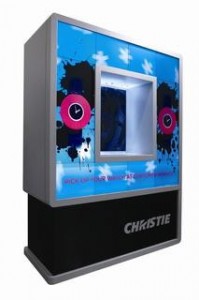Thanks to the team at DailyDOOH, we were privileged enough to get in early to work on what we think is now the most innovative screen platform out there – Christie Digital’s recently announced MicroTiles. Over the past year, Amigo Digital have had the opportunity to develop content for MicroTiles and explore the nature of this unique screen from a creative/design perspective.
 Alongside Arsenal Media we were the first content house to get our hands on a MicroTile and we were tasked with creating content for a range of applications where this product might be used – from Retail Environments, to Control Rooms, Digital Out Of Home Advertising scenarios to Public Spaces and Corporate Receptions. A huge variety of content and creative that would test any new screen in the marketplace.
Alongside Arsenal Media we were the first content house to get our hands on a MicroTile and we were tasked with creating content for a range of applications where this product might be used – from Retail Environments, to Control Rooms, Digital Out Of Home Advertising scenarios to Public Spaces and Corporate Receptions. A huge variety of content and creative that would test any new screen in the marketplace.
When we first got our hands on the MicroTiles we were like kids in a sweetshop – how does it work, what is the quality really like, do the units really just “click” together to make multiple shapes and sizes? After a few hours it became apparent that all our expectations were being met and well exceeded. And you simply cannot do justice with the written word as to the clarity and definition of this screen.
Due to the way in which the image is displayed and the technology involved, when you first see the image your initial instinct is to reach out and touch it, it is SO lifelike. There is absolutely no pixellation and the only way to describe the resulting image is that it has the quality of a hi resolution actual printed image but on a digital screen. What makes this kind of incredible image possible? 2 things from a visual/creative point of view – Blacks are REALLY BLACK – if you look at the black on an LCD or LED, the actual colour is a dark reflected grey NOT true black. On MicroTiles, Black really is very Black and this provides the designer with a massive range of contrast to use and so colours look especially good on the screens. Which brings us onto the 2nd point – the colour range. Colours look incredibly saturated and true – vivid, bright and they really pop out at you – which again from a design perspective can make anything you create look visually stunning.
Designing content for a screen such as this means thinking in a number of ‘smart’ ways. As the size and shape of the screen changes, so does the resolution – which starts out high in the first place. Dealing with hi resolution imagery as seen in the domain of the Print world does mean you need powerful hardware. The difference is that we aren’t just dealing with a single hi resolution image as in print, but 30 hi resolution frames per second as in the world of video/animation. Most designers in the DOOH space will be used to designing motion graphics of hi resolutions and the various challenges this poses – the difference with MicroTiles is that you are essentially creating even higher resolution moving imagery – so consideration for larger file sizes, increased processing time and disk space need to be taken into account. None of which is insurmountable as most of us have the computing power available to us and the results are certainly worth the effort!
In terms of the actual content and creative, vivid colours and blacks work extremely well and the Microtiles easily handle a range of more subtle shades and lighter colours. Motion is very smooth running at 30fps and the MicroTiles, and the multitude of back-end software playout systems that can be used, handle video content (when at the right resolution) as well as animation very well.
The only way to describe the end result is as Illustrious Moving Print – the blacks are a true black, the colours are saturated yet well defined, the overall clarity is pin sharp, text is legible and crystal clear and movement is smooth and precise. In a nutshell, MicroTiles are everything a moving image designer has been waiting for.

January 25th, 2010 at 12:41 @570
Is this tchnology Seamless ?
I heard Litemax have launched their Seamless Litile after half a year of R & D, producing whats said to be a product “too good” compared to it’s predecessor and given the Seamless litile is daylight viewable, what are christie offering ?
Will they get the colour balance in touch.
I’m trying to get a price from both Christie and Litemax – does anyone know and more importantly what brightness can they deliver ?
January 25th, 2010 at 13:02 @585
Dear Ivon@Shearline
For the uninitiated Shearline in Cambridge own the IP for ITrans (the ex Screen Technology business) as used by LiteMax in their LITile offering).
A couple of things: –
1. How much competitive research would you like us to do on your behalf?
2. Christie publish their brightness levels in their brochure. MicroTiles is 800nits and they (Chrsitie) would claim that they are REAL nits not marketing nits. If we remember correctly ITrans turned up full power was a lot, lot more than that but it was an outside product. Litemax is, what, 1200 nits (marketing or real?)
3. No tiled product is ever completely seamless. It’s the result of having a product that is not big and bulky, can be easily transported, fits through doors etc and (within reason) can be built into any shape you like. MicroTile seams are no more than 1mm